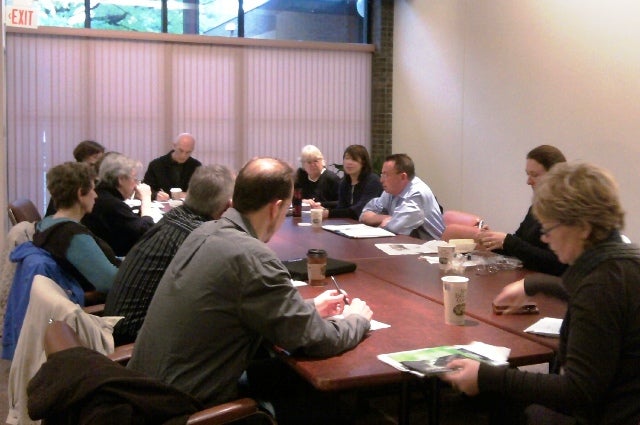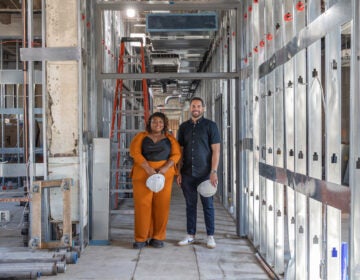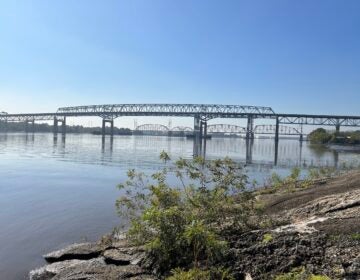A year of challenges and highlights for CDAG

Dec. 28
By Kellie Patrick Gates
For PlanPhilly
The Central Delaware Advocacy Group has just finished its first year as an independent entity. From fighting for a controversial zoning overlay and making itself heard on the Race Street Pier and Central Delaware Master Plan projects to piecing together its own bylaws and developing a more transparent process, 2009 has been busy.
At a recent public meeting about the selection of the Central Delaware Master Plan consultant, Mayor Michael Nutter praised the group. Tom Corcoran, president of the Delaware River Waterfront Corporation – the city agency that will oversee the implementation of the Central Delaware plan – credited CDAG’s outreach for two-thirds of the public turnout at that meeting.
“From our point of view, we could never effectively communicate with 15 separate community organizations individually,” Corcoran said. “We are relying on CDAG to disseminate information. We look at CDAG as our principal partners for this development.”
First, a bit of history. CDAG was created to advocate for the vision for the Central Delaware – a long-term view of what the river between Oregon and Allegheny avenues should eventually look like based on more than a year of public input. The document’s ideals will become the backbone of the now-underway master plan for the area, and would eventually be codified into city zoning laws. PennPraxis, which led the visioning process, was instrumental in creating CDAG. But this year, CDAG became a separate entity, with its own board of officers and bylaws. PennPraxis now has only an advisory role.
The organization has noted the increased attention it has been getting. “It’s good to hear we are developing a reputation as a credible, sensible presence,” said Chairman Steven Weixler. “I didn’t want us to be written off as a bunch of idealistic eggheads with an impossible dream.”
Weixler is especially pleased that CDAG has a seat on a DRWC committee that is called the “working group”. That body will interact with the consultants putting together the Master Plan for the Central Delaware.
PennPraxis Executive Director Harris Steinberg said the working group could be one of the venues through which CDAG meets its goal of making sure the objectives in the vision for the Central Delaware are met, but a spot on this committee or others like it should not be the only way. “Their real strength lies in the power of their voice as an advocacy group,” he said. In other words, Steinberg thinks CDAG must continue to agitate the powers-that-be in the same way activists do, even though they will sometimes be working with city leaders as partners.
Nutter, and Deputy Mayor for Planning and Commerce Alan Greenberger, and Corcoran have called the vision – which calls for linking city neighborhoods back to the water by extending the street grid, expanding public transit and down-playing the automobile, adding a multi-use waterfront trail and allowing a mix of dense development while preserving areas of open space – the “foundation document” for the master plan.
Still, it will take about 16 months for the plan to be completed. In an attempt to prevent any development that would run contrary to those goals, First District City Councilman Frank DiCicco wrote legislation creating a temporary zoning overlay. Much of CDAG’s work during the first half of this year was focused on getting the overlay passed.
Greenberger attended CDAG meetings, and so did DiCicco’s policy chief, Brian Abernathy. As hard as CDAG was pushing for the overlay, a group of landowners and developers was pushing against it – or at least major portions of it. Central to the disagreement was a 100-foot setback. CDAG members felt it absolutely necessary for the future of the waterfront. Members of a pro-development non-profit called the Development Workshop – led by movers-and-shakers Craig Schelter and Michael Sklaroff – said that 100 feet was much too much for some parcels, and that it amounted to taking of land without compensation.
Abernathy, DiCicco and top city planning officials also met with the Development Workshop. And DiCicco and Abernathy brought everyone together to talk about their differences.
In June, the overlay passed with a setback of 100 feet or 10 percent of any property, whichever is less.
The Workshop still has major concerns about the setback, and what it means for the Master Plan.
CDAG wasn’t completely satisfied, either. It would have preferred 100 feet or 20 percent of a property to be the standard. But when the legislation was before City Council, CDAG pushed hard for it, without mentioning this issue. And when it passed, Weixler said he felt like handing out cigars, anyway.
“Even though it is not perfect, it is a major place holder until we get the Master Plan,” Weixler said in a recent interview.
Abernathy said CDAG was “very important” in getting the legislation passed. “They did a great job in their first year, and they’ve been great partners,” he said.
Steinberg noted that not only did the overlay pass, but the Nutter administration has been following the recommendations in the Central Delaware Action Plan – a document put together by PennPraxis and CDAG – that outlines steps the city should take to turn the vision into reality. Among the key recommendations: Dissolving the Penn’s Landing Corporation, which was often criticized for failing to make anything of the waterfront, and replacing it with the Delaware River Waterfront Corporation.
“They have been key players in helping to move, change, and implement policy in Philadelphia,” Steinberg said. “That’s the greatest sign of success.”
Not all of CDAG’s goals for this year were met, however. And there was at least one awkward moment for the group.
At the November public forum about the master plan candidate finalists, CDAG was going to release a report card on the implementation of the city’s long-range waterfront goals. But at the last minute, under criticism from DRWC, Greenberger and Abernathy, CDAG changed its mind. The issues: Those responsible for implementing the Action Plan for the Civic Vision had no idea a report card was coming out. They said they felt blindsided.
It was clear at the next CDAG meeting following the event that some CDAG members felt they had narrowly missed making a huge mistake. Others seemed more concerned that the decision to hold the document might signal that CDAG was giving those they were supposed to be watching on behalf of the public the power to edit their report.
By the end of the meeting, CDAG reached consensus that it was proper to give the organizations a heads-up – but a heads-up only. They also decided to re-tool the report card into more of a progress report, since some of the long-term goals could not possibly be met this soon. That is expected to be released in early 2010.
There seem to be no hard feelings left.
“In terms of our long-term relationship with CDAG, it had no effect at all,” Corcoran said.
“Whatever mistakes or miscommunications were made, I don’t think any were significant – and there are none that haven’t been resolved,” Abernathy said. “We all had missteps in the last year.”
A central principle of the organization is transparency, and a key goal is to keep information flowing to the public.
Some steps have been taken in that direction. CDAG has a professional-looking logo designed by Penn students. It has appeared on T-shirts and printed materials that have been circulated at public events.
CDAG has a website, but it is not frequently updated. The organization is working on getting a new website that will be filled with current information up and running in the near future.
And while CDAG’s meetings are open to the public, they are not regularly advertised anywhere, and are held at 8 a.m. in the small Society Hill Towers community room. They are always held on the second Thursday of each month, but CDAG does not advertise the dates and times.
Weixler said the early morning meeting time is when CDAG members – most of whom have other jobs and are very active in at least one other organization – can get together. Money is also an issue – CDAG has very little bankroll (raising funds is another goal) and the space at the Towers is provided at no cost.
But while most regular board meetings will be held at the same place and time, Weixler said CDAG will begin holding meetings at night in bigger places when there are important waterfront items to discuss. It would be good to move the locations up and down the waterfront neighborhoods, he said.
CDAG can not afford to pay to advertise the meetings anywhere, either, he said. (Since CDAG is not a government agency, it does not have to by law.) The new-and-improved website will take care of that function, too, Weixler said.
CDAG recently finished a retreat at which members discussed goals for the organization in the coming year.
The group wants to do more to help its member organizations, he said. “We’re looking not to be big brother, but big helper,” he said. For example, he said, CDAG might be able to help civics who don’t have architects or planners as members better understand development proposals that they must consider.
CDAG would also like to serve as a liaison of sorts between DRWC and the public, he said. CDAG could explain riverfront proposals to community groups and take their reactions back to the DRWC before the corporation holds a public meeting on the proposal, Weixler said. This would help better prepare the public, he said, because they would already be familiar with what was on the table, and would have a chance to get basic questions answered about a proposal asked ahead of time.
Such a role for CDAG would also be helpful to the DRWC, he said, because CDAG could give the corporation a heads-up on items that will likely be sticking points for the public.
Contact the reporter at kelliespatrick@gmail.com
WHYY is your source for fact-based, in-depth journalism and information. As a nonprofit organization, we rely on financial support from readers like you. Please give today.





